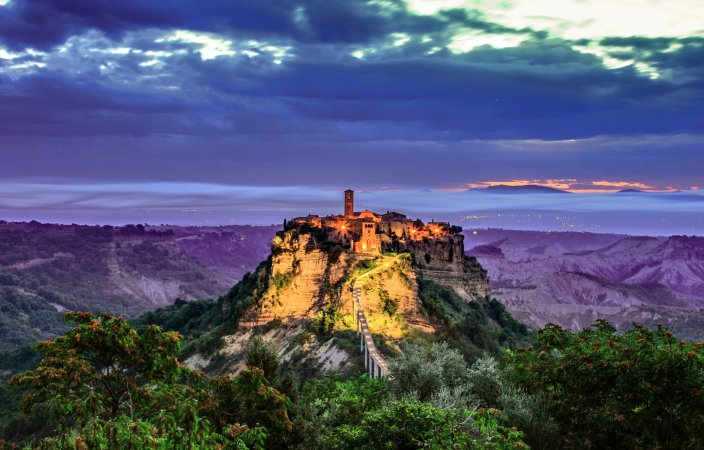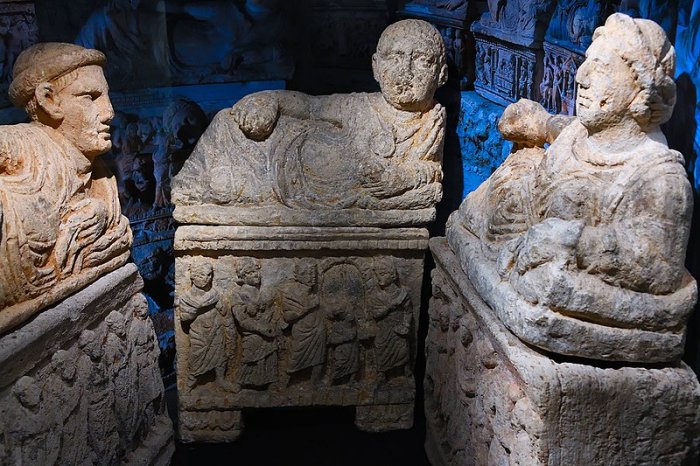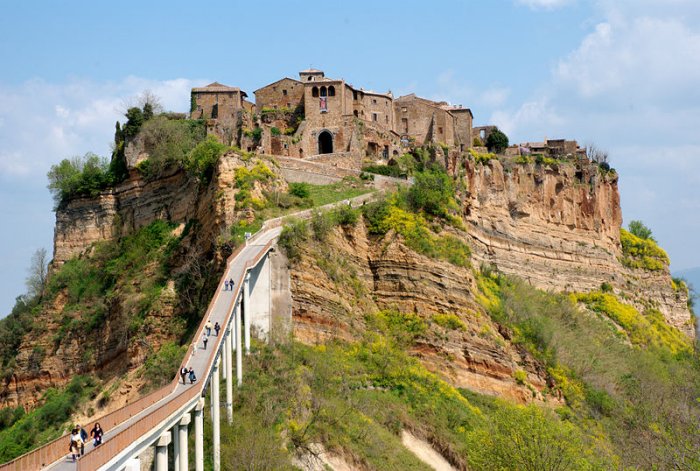Civita di Bagnoregio – Magnificent 2,500-Year-Old Etruscan City In The Sky Is Struggling To Survive
Jan Bartek - AncientPages.com - Those who would like to visit Civita di Bagnoregio should be prepared to walk a lot. The only way to access the Italian hill town Civita di Bagnoregio is by foot through a bridge restricted to pedestrians. It takes a while to reach the top, and the walk can be tiresome, especially in the summer, but it is worth the effort.
Located about 100 kilometers north of Rome, in the comune of Bagnoregio, this tiny little town is remarkably rich in ancient history.
Civita Di Bagnoregio amidst mountains at dusk. Credit: Adobe Stock - thomas saller/EyeEm
Civita di Bagnoregio has been built and rebuilt over the centuries. It has been challenging to determine precisely when its buildings were constructed, but scholars say there is clear evidence of Etruscan activity at the site.
It has even been suggested the original site may even be pre-Etruscan.
Civita di Bagnoregio Was Home To Etruscans
Founded by the Etruscans about 2,500 years ago, Civita di Bagnoregio offers delight to those who want to get a glimpse into the past.
"The Etruscans chose the town site for its defensible position on a peninsula separated by shear cliffs from a surrounding valley." 1
"About 3000 years ago, a mysterious people called the Etruscans settled in a region of Central Italy was known as Etruria.
Etruscan urns. Credit: Dosseman - CC BY-SA 4.0
Despite that these ancient people were much closer to us in time, they were even more enigmatic and inaccessible than other ancient cultures such as Crete, Mesopotamia, or Mycenae, and we have still much to learn about them." 2
Civita di Bagnoregio can provide historians additional information about the Etruscans' beliefs, traditions, and culture in general. Civita was part of Etruria, which had its capital at "Vulsinium", the current Orvieto.
In ancient times there were five city gates that offered access to the old town of Civita, and there was a road that linked the Tiber Valley to Lake Bolsena. The place was somewhat easier to reach in those days, but the Etruscans knew the location was adequate to feel safe from enemies. Still, the Etruscans turned the town into a flouring center because of its strategic position favorable for trade and proximity to the most important communication routes of the times.
The Underground World Beneath Civita di Bagnoregio
Civita di Bagnoregio is home to a vast underground world consisting of fascinating caves that were first used by the Etruscans and later by the Romans who modified the grottoes.
Beneath many houses and gardens, there is a large underground complex, about three levels below the street.
"Temperatures in the bottom-most caves stay a constant 14c degrees/ 54F degrees.
Some believe the caves may also have been ancient tombs, however, Etruscans usually buried their deceased outside of their towns."3
Most likely, many of the caves were used for food, olive oil, and wine storage.
Civita di Bagnoregio, Viterbo, Lazio, Italy. Credit: Dalem - CC BY 2.0
In ancient times, chamber tombs were visible, but earthquakes have destroyed part of Civita di Bagnoregio on a couple of occasions.
In 265 B.C., when Romans reached Civita di Bagnoregio they made many modifications and improved rainwater drainage and many buildings.
"Most of the buildings standing now were originally constructed during the Middle Ages 300-1100 AD, with the current church structure and bell tower likely built around 600AD.
Medieval Civita was probably a walled city dotted with towers, most fallen or taken down due to earthquake risk. The thick wall bases of the towers are still evident in plan.
In 1140, Civita became a free commune, leading to an era of prosperity. Renaissance Civita in the 1500's saw a period of wealth and prestige when several palazzi or palaces were built by noble families along the town's main street.
In 1695, a series of catastrophic earthquakes destroyed much of Civita, resulting in a steady decline in population and importance ever since. The seat of government and cathedral was moved to Bagnoregio. By WWII, many of the buildings were in ruins." 3
"The city's most famous native was the 13th Century philosopher and Saint Bonaventure." 4
Will Civita di Bagnoregio Survive?
After much of the town was destroyed, Civita di Bagnoregio was rebuilt by its residents, and the historic site has become a tourist attraction. But it cannot be denied, but this ancient tiny town is facing severe problems. Today, Civita di Bagnoregio is often referred to as "the dying town" due to its susceptibility to erosion and landslides. The erosion is in fact, the reason why most people left the town.
"Erosion over time has increased the isolation, and the town is now an island linked with the rest of the world by a foot bridge. The isolation has preserved the largely medieval character of the built environment.
Civita di Bagnoregio. Credit: Etnoy - CC BY-SA 4.0
The social and economic base for the town has shifted greatly over the last few decades, as property has been acquired by outsiders for vacation use and self-sufficient farming has steadily declined." 1
Civita di Bagnoregio is dying, but it is a slow death, and perhaps there is still time to save this historic place that has struggling to survive all those years, or maybe there is no hope at all.
Declared one of the most beautiful towns in Italy, Civita di Bagnoregio has less than 12 year-round occupants and it receives as many as 3,000 tourists a day on summer weekends.
Some organizations have hope it is possible to modernize and preserve Civita di Bagnoregio. Still, many feel this ancient site "will inevitably disappear when the final pieces crumble into the spectacular Valle dei Calanchi below. Knowing this and knowing that nothing can be done to prevent it makes your visit all the more special and… macabre." 4
Civita di Bagnoregio has been nicknamed the 'Dying City' or the 'City in the Sky .' Those of us who love ancient history prefer the latter name.
Written by Jan Bartek - AncientPages.com Staff Writer
Copyright © AncientPages.com All rights reserved. This material may not be published, broadcast, rewritten or redistributed in whole or part without the express written permission of AncientPages.com
Expand for references- Watts, C., & Watts, D. (1992). A Reappraisal Of Isolation; An Italian Hill Town In The Computer AgeTraditional Dwellings and Settlements Review, 4(1), 51-51.
- Sutherland - Mysterious Etruscans: Skilled Sailors And Master Craftsmen, AncientPages.com
- Stephanie Bower, Civita Institute/NIAUSI - A Walking Guide to the Architecture of Civita di Bagnoregio ITALY - civitainstitute.org
- Civita di Bagnoregio
More From Ancient Pages
-
 Spartacus: The Rise And Fall Of An Unlikely Hero
Featured Stories | Oct 4, 2022
Spartacus: The Rise And Fall Of An Unlikely Hero
Featured Stories | Oct 4, 2022 -
 Isaac Newton Believed Egyptian Pyramids Held Key To The Apocalypse – Unpublished Manuscripts Reveal
News | Dec 10, 2020
Isaac Newton Believed Egyptian Pyramids Held Key To The Apocalypse – Unpublished Manuscripts Reveal
News | Dec 10, 2020 -
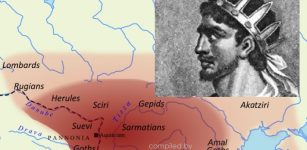 Attila The Hun: The Destroyer Of Rome Among Most Fearsome Enemies The Empire Ever Faced
Featured Stories | Jun 24, 2019
Attila The Hun: The Destroyer Of Rome Among Most Fearsome Enemies The Empire Ever Faced
Featured Stories | Jun 24, 2019 -
 Freemasons Secrets – American Democracy Is Part Of An Ancient Universal Plan – The Beginning And The Dream Of A Brotherhood Of Men – Part 1
Civilizations | Jul 12, 2018
Freemasons Secrets – American Democracy Is Part Of An Ancient Universal Plan – The Beginning And The Dream Of A Brotherhood Of Men – Part 1
Civilizations | Jul 12, 2018 -
 Evidence Of Early Metalworking In Arctic Canada – European Technologies Involved
Archaeology | Dec 7, 2014
Evidence Of Early Metalworking In Arctic Canada – European Technologies Involved
Archaeology | Dec 7, 2014 -
 Famed Makishi Dancers And Likumbi Lya Mize Ceremony In Zambia – Much More Than Just A Festival
Ancient Traditions And Customs | Aug 6, 2019
Famed Makishi Dancers And Likumbi Lya Mize Ceremony In Zambia – Much More Than Just A Festival
Ancient Traditions And Customs | Aug 6, 2019 -
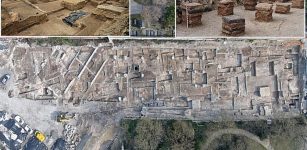 A Huge Site Dated To Roman-Era Unearthed In Reims (Marne), France
Archaeology | Mar 20, 2023
A Huge Site Dated To Roman-Era Unearthed In Reims (Marne), France
Archaeology | Mar 20, 2023 -
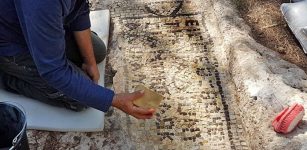 1,600-Year-Old Estate Of Wealthy Samaritan With A Rare Greek Inscription – Discovered
Archaeology | Mar 6, 2019
1,600-Year-Old Estate Of Wealthy Samaritan With A Rare Greek Inscription – Discovered
Archaeology | Mar 6, 2019 -
 Mystery Of Europe’s Bog Body Phenomenon Solved By Scientists
Archaeology | Jan 12, 2023
Mystery Of Europe’s Bog Body Phenomenon Solved By Scientists
Archaeology | Jan 12, 2023 -
 Incredible Ancient Star Map Depicting Our Galaxy Is Hidden In Africa
Featured Stories | Aug 4, 2018
Incredible Ancient Star Map Depicting Our Galaxy Is Hidden In Africa
Featured Stories | Aug 4, 2018 -
 Discovery Of Chromosomes Offers Evidence Of Ancient Humans Living In South America Over 18,000 Years Ago
Archaeology | Aug 21, 2022
Discovery Of Chromosomes Offers Evidence Of Ancient Humans Living In South America Over 18,000 Years Ago
Archaeology | Aug 21, 2022 -
 Sirrush – Powerful “Glamorous Snake” Guarded Marduk But Did This Hybrid Really Exist?
Featured Stories | Apr 29, 2022
Sirrush – Powerful “Glamorous Snake” Guarded Marduk But Did This Hybrid Really Exist?
Featured Stories | Apr 29, 2022 -
 Heimdallr: Norse God That ‘Illuminates The World’ And Guards The Rainbow Bridge Bifrost In Asgard
Featured Stories | Feb 6, 2016
Heimdallr: Norse God That ‘Illuminates The World’ And Guards The Rainbow Bridge Bifrost In Asgard
Featured Stories | Feb 6, 2016 -
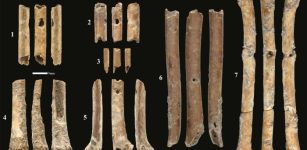 12,000-Year-Old Flutes Made From Bird Bones – Discovered
Archaeology | Jun 10, 2023
12,000-Year-Old Flutes Made From Bird Bones – Discovered
Archaeology | Jun 10, 2023 -
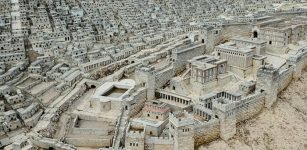 Early City Planning In The Kingdom Of Judah Examined
Archaeology | Jul 5, 2023
Early City Planning In The Kingdom Of Judah Examined
Archaeology | Jul 5, 2023 -
 Why Was Celebration Of Christmas, Easter, Midsummer And Saint’s Day Forbidden In Scotland?
Ancient History Facts | Dec 27, 2019
Why Was Celebration Of Christmas, Easter, Midsummer And Saint’s Day Forbidden In Scotland?
Ancient History Facts | Dec 27, 2019 -
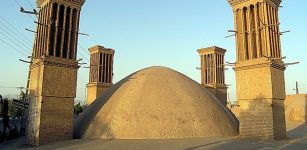 Remarkable Ancient Windcatchers: Air Conditioning Systems Built Since Antiquity
Ancient Technology | Sep 3, 2016
Remarkable Ancient Windcatchers: Air Conditioning Systems Built Since Antiquity
Ancient Technology | Sep 3, 2016 -
 Number Nine: Sacred Symbol In Ancient Cultures
Ancient Symbols | Feb 14, 2017
Number Nine: Sacred Symbol In Ancient Cultures
Ancient Symbols | Feb 14, 2017 -
 Altai Mountains Were Home To Porcupines 30,000 Years Ago
Archaeology | Mar 14, 2017
Altai Mountains Were Home To Porcupines 30,000 Years Ago
Archaeology | Mar 14, 2017 -
 On This Day In History: The Warsaw Uprising Began – On August 1, 1944
News | Aug 1, 2016
On This Day In History: The Warsaw Uprising Began – On August 1, 1944
News | Aug 1, 2016

